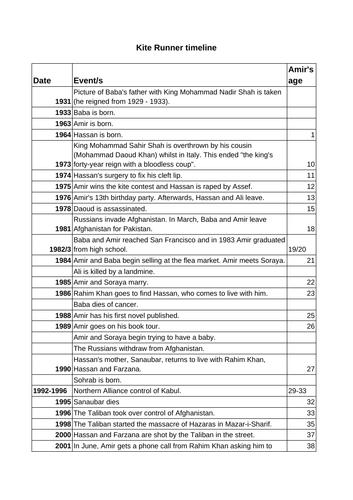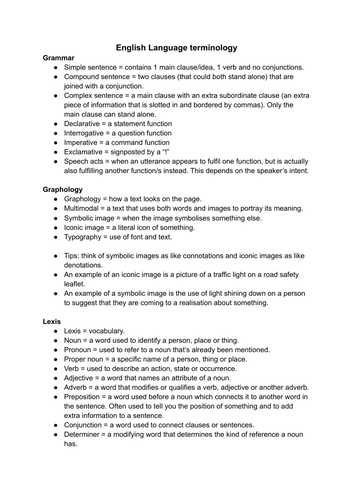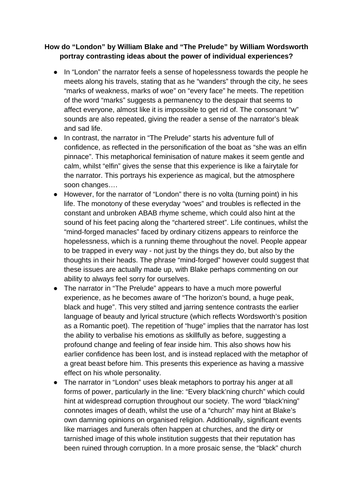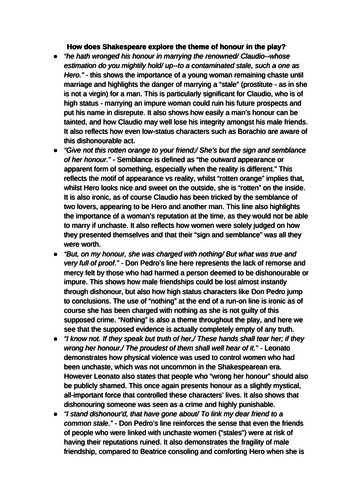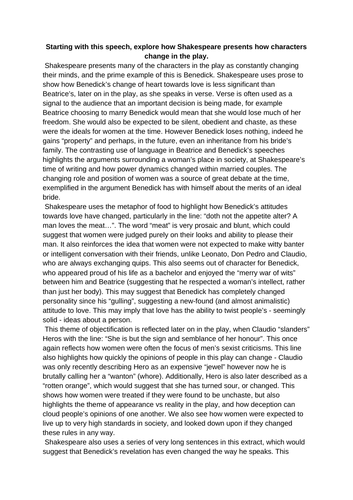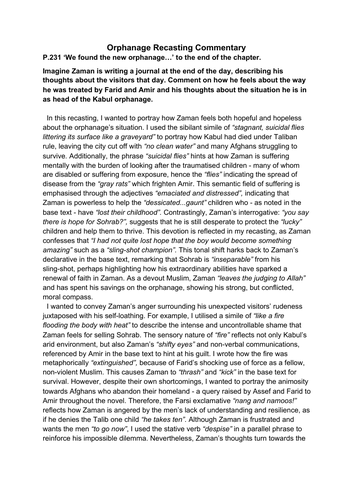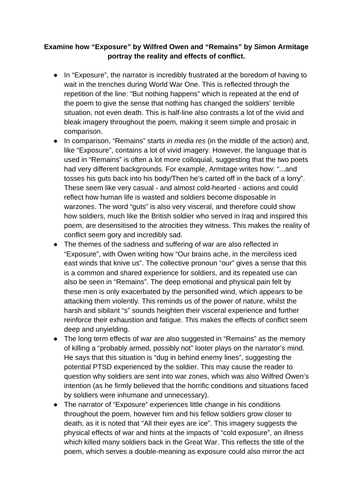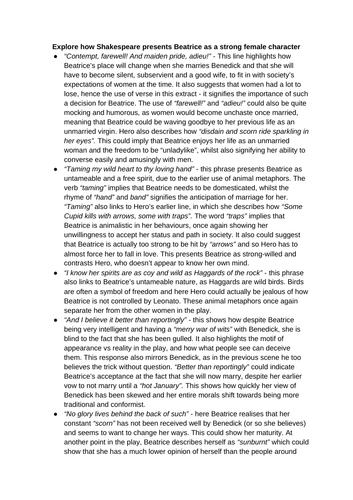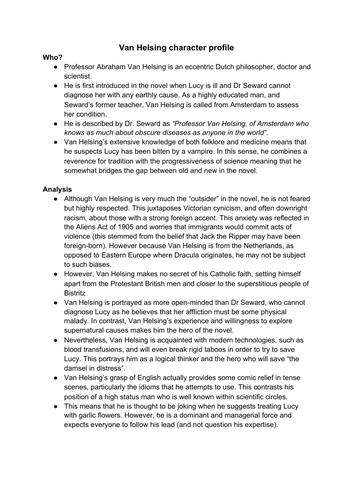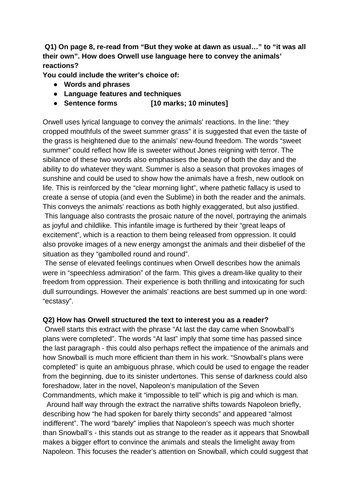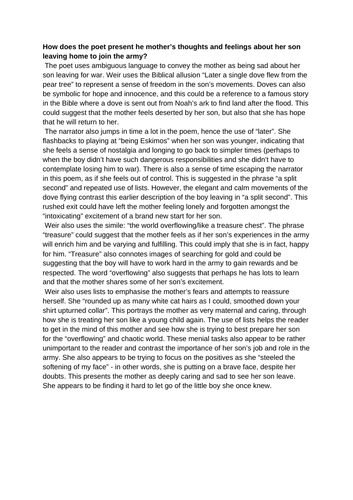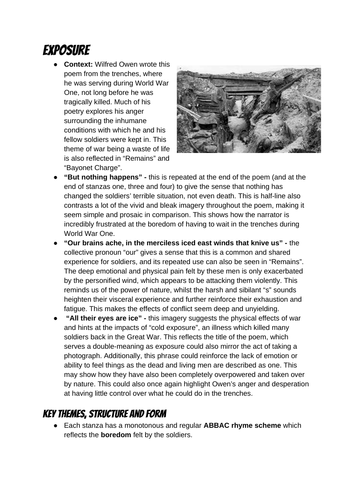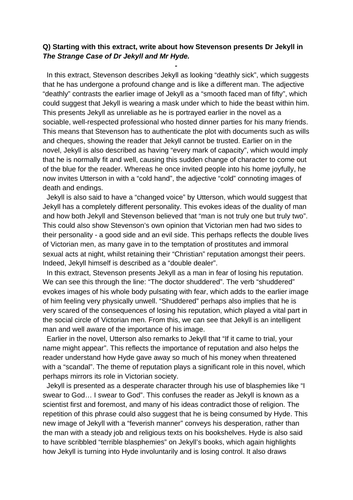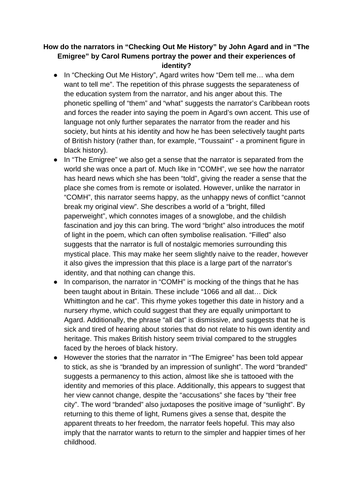
214Uploads
85k+Views
6k+Downloads
English language arts

The Kite Runner Timeline A Level English Lang and Lit
This handy timeline includes all the key events from Khaled Hosseini’s the Kite Runner, as studied at AS/A Level AQA English Language and Literature.

AS/A Level English Language and Literature terminology list
This 6 page document includes all the key terminology and definitions that A Level English Lang and Lit students studying the AQA course need to know. The lsit is disaggregated by language level (phonology, lexis, semantics, grammar, graphology, discourse, pragmatics) and it also includes key ideas like goodwin’s story structure and labov’s narrative framework, as well as Grice’s cooperative principles.

How do “London” and “The Prelude” portray contrasting ideas about individual experiences?
A helpful revision sheet with some key quotes and in depth analysis of “London” by William Blake and “The Prelude: stealing the boat” by William Wordsworth, using techniques such as oxymoron, personification and metaphor. Explores the structure, context, form and language of each poem and their similarities and differences. Designed specifically for AQA GCSE English Lit (higher ability sets), studying the Power and Conflict poetry anthology.

How does Shakespeare explore the theme of Honour in "Much Ado about Nothing?"
A summary of how Shakespeare intergrates the theme of honour in “Much Ado” Suitable for GCSE English literature and designed specifically as a revision tool for the AQA course. Helps students learn quotes and understand Shakspearean language. Provides detailed analysis, links to context and the rest of the play. Can be used for homework or in class.

GCSE English AQA Much Ado about Nothing model essay answer (band 6)
A model essay (that would be well into the highest band) that answers the question: “Starting with this speech, explore how Shakespeare presents how characters change in the play”. Can be used for students to compare their answers to or in class as an analysis task (e.g picking out the technique, word analysis, context, etc.). Specifically designed for the AQA GCSE English specification but can be used on any exam board that uses this Shakespearean text.

A Level Kite Runner recasting and commentary model answer top band
This recasting (using a section from chapter 20, highlighted for AO2 and AO4) and commentary achieved close to full marks and answers the question: Read P.231 ‘We found the new orphanage…’ to the end of the chapter.
Imagine Zaman is writing a journal at the end of the day, describing his thoughts about the visitors that day. Comment on how he feels about the way he was treated by Farid and Amir and his thoughts about the situation he is in as head of the Kabul orphanage.
Suitable for the A Level AQA English Language and Literature course, for students studying the Kite Runner by Khaled Hosseini.

Cristina by Robert Browning summary sheet A Level English literature poetry
This summary sheet contains an overview as well as the key themes, context, language analysis and structure/form about this Robert Browning poem. Perfect for revision.

How Beatrice is presented in "Much Ado about Nothing"
A Summary of some quotes in Shakespeare’s comedy, along with a detailed analysis of each of them and how they link to context and different points in the play

How does Stevenson present Hyde as an evil character in The Strange Case of Dr Jekyll and Mr Hyde?
A model answer (band 5, at least) for the question : “Explore how Stevenson presents Hyde as an evil character in The Strange Case of Dr Jekyll and Mr Hyde”. Should be an accompanying extract. Written for the AQA GCSE 9-1 spec (English Lit).

Examine how “Exposure”and “Remains” portray the reality and effects of conflict/war
A revision sheet answering the question: Examine how “Exposure” by Wilfred Owen and “Remains” by Simon Armitage portray the reality and effects of conflict. Contains detailed language analysis as well as contextual references, structure and form. The key themes of both poems are also explored in easy-to-read bullet points which link together. Specifically written for the AQA GCSE English Lit Paper 2 Power and Conflict poetry anthology.

Explore how Shakespeare presents Beatrice as a strong female character GCSE English Lit model essay
A few analysed quotes and paragraphs from Much Ado about Nothing around the topic of Beatrice as a strong female character. This question came up in the 2019 AQA GCSE English Lit Paper 1, so is definitely worth practicing! Detailed word analysis and use of developed points.

Van Helsing character profile - Dracula, A Level English Language and Literature
A comprehensive profile introducing the character of Van Helsing in Bram Stoker’s Dracula. Includes an introduction to the character, analysis and points where they appear in the novel. This will help your A Level English Language and Literature (AQA) students to make links to other points within the novel in their answers, as well as providing some context.

Explore how Shakespeare presents Benedick’s attitudes to love
This is a model answer (at least high band 5) that answers the questions: “Explore how Shakespeare presents Benedick’s attitudes to love”. This also accompanies an extract from the play. Perfect for AQA GCSE English Lit 9-1 course.

Animal Farm GCSE English Lit exam questions
3 exam questions that answer: “On page 8, re-read from “But they woke at dawn as usual…” to “it was all their own”. How does Orwell use language here to convey the animals’ reactions?
You could include the writer’s choice of:
Words and phrases
Language features and techniques
Sentence forms”
and: “Q2) How has Orwell structured the text to interest you as a reader?”
As well as: “Q3) “Animal Farm is really about how language erodes people’s ability to think for themselves”.
To what extent do you agree?”
All are model answers and into the top band for the AQA GCSE English Literature specification (but of course could be used for any course). Handy for analysing in revision and getting students to write their own versions. Contains detailed language analysis and key terms, as well as intergrated quotations.

GCSE English AQA Power and Conflict poetry "Poppies" by Jane Weir model answer
A model answer (top grades) to the question: “How does the poet present the mother’s thoughts and feelings about her son leaving home to join the army?”. This answer is an unseen poetry practice, however you could use this essay to analyse and “mark” with students in class or for homework. Designed specifically for the AQA GCSE English Lit Power and Conflict poetry cluster for “Poppies” by Jane Weir, but could be used for any exam board that uses this poem. Explores symbolism, structure, allusion and word analysis.
Bundle

GCSE English Lit Jekyll and Hyde model answers and revision
A few model answers and revision guides to help students revise. Can be analysed in lessons too. All essays are in the top band. The picture of the cover image is from a google search and from: http://theapopkavoice.com/jekyll-hyde/

Exposure by Wilfred Owen GCSE English Lit revision guide
A handy revision guide containing detailed language analysis of several key quotes from this poem from the AQA GCSE English Lit Power and Conflict poetry cluster. Also includes: context, structure, form and key themes incorporated into linked bullet points. Can be used in class or set for students’ own at home revision.

GCSE English lit Jekyll and Hyde model answer exam question practice
A model answer (top bands) for the question: “Q) Starting with this extract, write about how Stevenson presents Dr Jekyll in The Strange Case of Dr Jekyll and Mr Hyde”. Designed specifically for the AQA GCSE English lit spec.

Tissue by Imtiaz Dharker GCSE English Lit revision guide
A handy revision guide containing detailed language analysis of several key quotes from this poem from the AQA GCSE English Lit Power and Conflict poetry cluster. Also includes: context, structure, form and key themes incorporated into linked bullet points. Can be used in class or set for students’ own at home revision. Includes an exam-style question at the end.

How does “Checking Out Me History” and “The Emigree” portray the power of identity?
A useful bullet point list of developed paragraphs that answer the question: How do the narrators in “Checking Out Me History” by John Agard and in “The Emigree” by Carol Rumens portray the power and their experiences of identity? This includes detailed and higher level language analysis, use of terminology like metaphor and analysis of structure and form. Also addresses the key themes of each poem and the context surrounding them. Designed specifically for the AQA GCSE English Lit 9-1 Power and Conflict poetry cluster.

